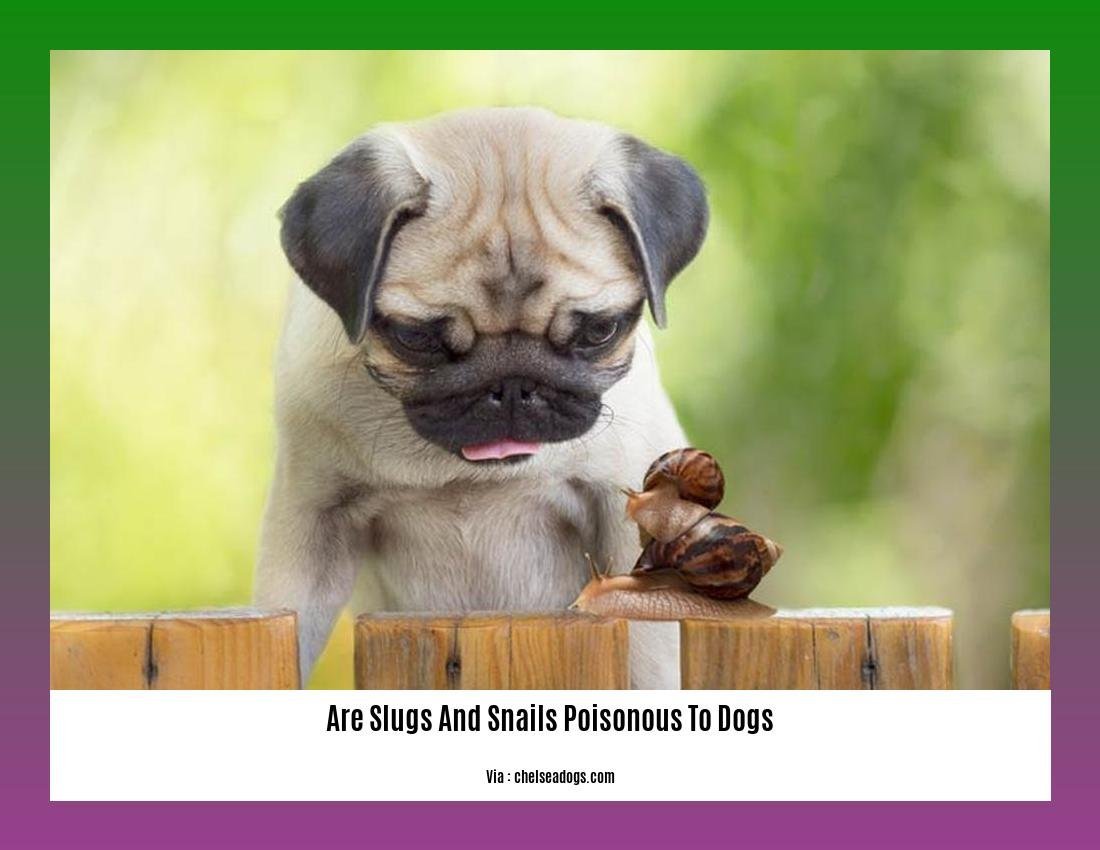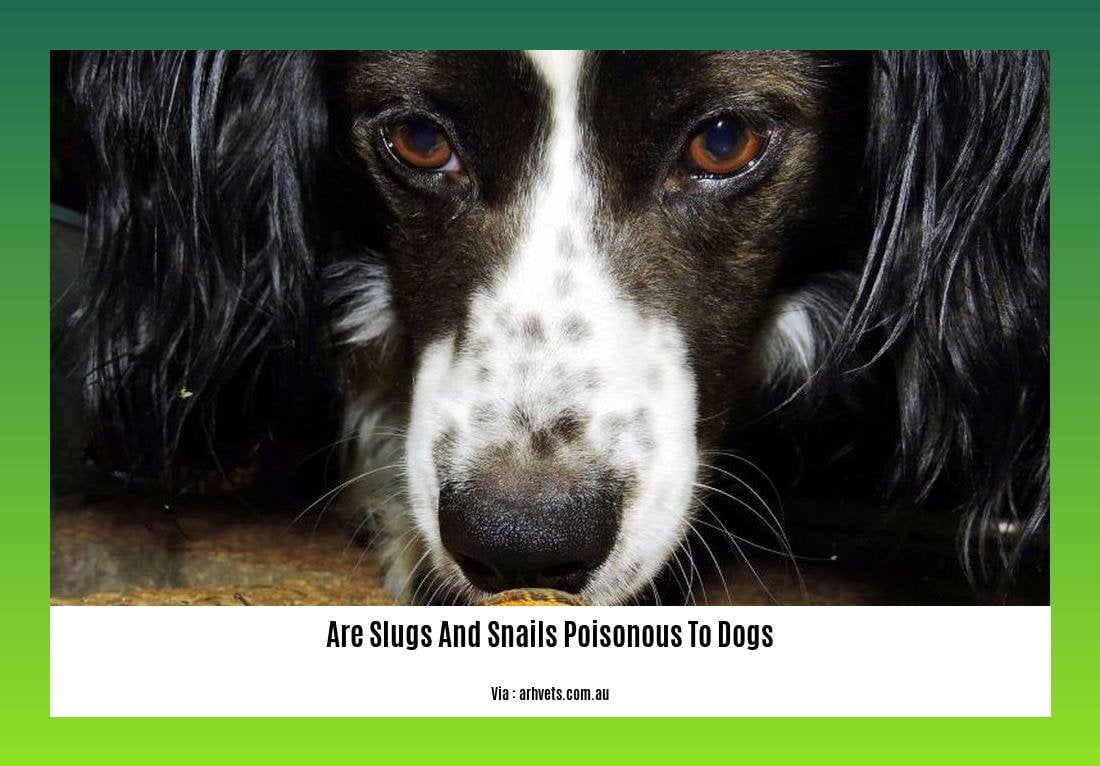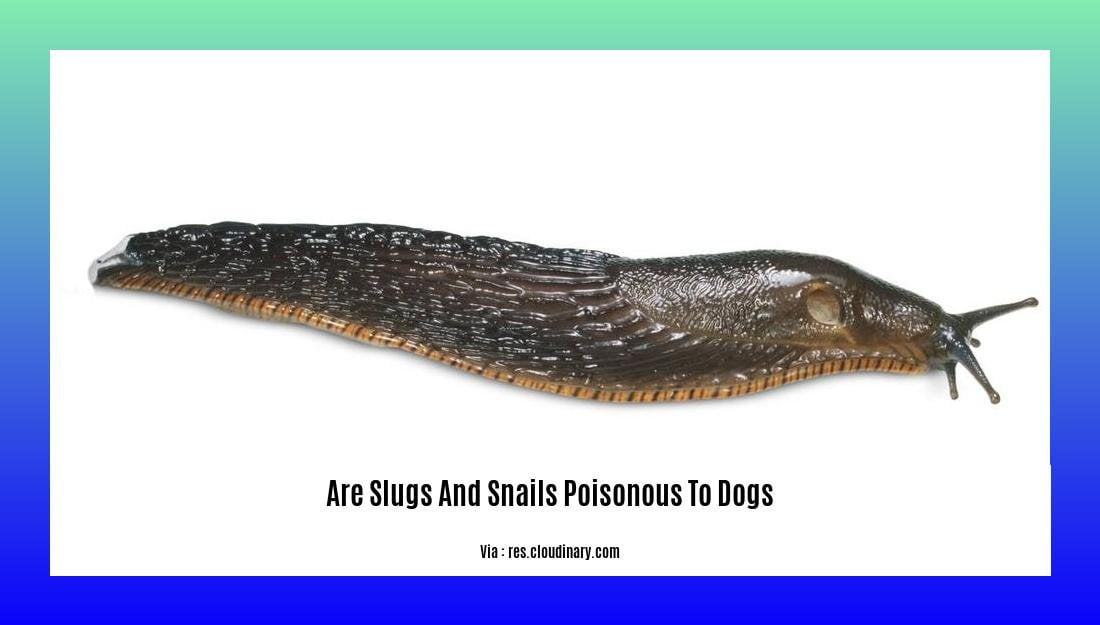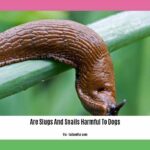Understanding the Risk: Are Slugs and Snails Poisonous to Dogs?
In the world of pet care, ensuring the safety and well-being of our furry friends is paramount. As responsible pet owners, we often find ourselves questioning whether certain creatures pose a threat to our dogs. One such concern that frequently arises is whether slugs and snails can be poisonous to our canine companions. In this article, we will delve into this topic, examining the potential dangers these slimy creatures may present and providing valuable insights to help pet owners make informed decisions and protect their beloved dogs from any potential harm.
Key Takeaways:
- Slugs and snails can pose a serious threat to dogs if consumed, as they can carry lungworm larvae and transmit filariasis.
- Lungworm infection can lead to breathing problems, bleeding, and even death in dogs.
- Filariasis can cause heartworm, a life-threatening condition that affects a dog’s cardiac health.
- Prevention is crucial, and responsible pet owners should keep their dogs away from areas where slugs and snails are commonly found, such as gardens or damp areas.
- Promptly removing any slugs or snails that are spotted can also help prevent ingestion.
- It is advisable to contact a veterinarian if a dog has come into contact with slugs or snails, even if they haven’t been consumed.
- Vigilance and taking preventative measures are essential for ensuring the safety and well-being of dogs.
Are Slugs and Snails Poisonous to Dogs?

Slugs and snails may seem harmless, but when it comes to our canines, they can pose a significant threat. These slimy creatures can carry various parasites that can lead to severe health issues in dogs. In this article, we will explore the potential dangers of slugs and snails, how they can harm our furry friends, and what steps we can take to keep them safe.
The Hidden Dangers
Did you know that slugs and snails can carry lungworm larvae? These parasites can infect our dogs’ lungs and cause a range of health problems, including breathing difficulties, bleeding, and even death. Additionally, these creepy crawlies can transmit filariasis, a disease that causes heartworm in dogs. Heartworm is a life-threatening condition that can profoundly affect a dog’s cardiac health [^1^][^2^].
Prevention is Key
As responsible pet owners, it is crucial to take measures to protect our dogs from ingesting slugs and snails. While it may not be easy to determine if a slug or snail is infected with harmful parasites, prevention is our best defense. Here are some steps you can take:
Limit exposure to slugs and snails: Be mindful of areas where slugs and snails are commonly found, such as gardens or damp areas. Restrict your dog’s access to these locations to minimize the risk of contact.
Prompt removal: If you spot any slugs or snails in your dog’s vicinity, make sure to remove them promptly. Wear gloves to avoid direct contact and dispose of them properly.
Vigilance after contact: If your dog has come into contact with slugs or snails, even if they haven’t been consumed, it is advisable to seek veterinary advice. A professional can provide guidance on any precautionary measures or monitoring that may be necessary.
Conclusion
Although slugs and snails may seem harmless, they can pose a significant threat to our dogs’ health. Lungworm and heartworm infections can have devastating consequences, but by being vigilant and taking preventative measures, we can ensure the safety and well-being of our beloved pets. Remember, prevention is key when it comes to protecting our dogs from the potential dangers of slugs and snails. Stay informed, stay alert, and keep your furry friends safe.
Sources:
- Pet Dog World. Slugs and Snails can be Harmful to Dogs if Eaten
- AnimalWised. What Happens if My Dog Eats a Snail? – Are Snails Poisonous to Dogs?
Are you wondering if ramshorn snails are good for ponds? Find out by clicking here.
Concerned about the safety of your furry friend? Discover if slugs and snails are dangerous to dogs here.
Worried about potential harm to your dog? Click here to learn if slugs and snails are harmful to dogs.
Potential Dangers and Risks Associated with Slugs and Snails for Dogs
As pet owners, we want to ensure the safety and well-being of our beloved canine companions. That’s why it’s important to be aware of the potential dangers and risks associated with slugs and snails when it comes to our dogs. While these creatures may not be directly poisonous, they can carry harmful parasites and diseases that can pose a threat to a dog’s health. Let’s dive deeper into these risks and how to keep our furry friends safe.
Parasites and Diseases Carried by Slugs and Snails
Slugs and snails can be carriers of lungworm larvae, which can lead to severe health problems if a dog ingests them. Lungworm infection can cause breathing difficulties, coughing, bleeding, and even death if not treated promptly. Additionally, these creatures can transmit filariasis, also known as heartworm, to dogs. Heartworm is a life-threatening condition that affects a dog’s cardiac health. It is crucial to understand that the risks extend beyond direct consumption as dogs can also become infected by coming into contact with slugs, snails, and their slime.
Preventive Measures to Safeguard Your Dog
To protect your dog from the potential dangers of slugs and snails, it’s important to take preventive measures. Here are some practical tips to keep in mind:
Minimize Exposure: Limit your dog’s exposure to areas where slugs and snails are commonly found, such as gardens, yards, and outdoor play areas.
Regular Cleanup: Regularly clean up your yard, removing any damp or shady spots where slugs and snails might thrive. Pay special attention to areas near water sources as slugs and snails are attracted to moisture.
Remove Attractants: Avoid leaving toys, pet food, or chews outside where slugs and snails can crawl over them. These creatures are attracted to the smell of food and can easily contaminate it with their slime.
Water Source Safety: Provide clean water for your dog to drink. Slugs and snails can contaminate outdoor water bowls, puddles, or ponds, so ensure your dog has access to a clean water source to prevent them from drinking water that may be contaminated.
What to Do If Your Dog Comes into Contact with Slugs or Snails
If your dog has come into contact with slugs or snails, it’s important to take prompt action. Here are the steps to follow:
Check for Signs of Infection: Monitor your dog for any signs of infection, such as coughing, breathing difficulties, unexplained bleeding, or changes in behavior. If you notice any of these symptoms, seek veterinary advice immediately.
Consult with Your Veterinarian: If you suspect your dog may have ingested slugs, snails, or their slime, or if they are showing any symptoms of infection, consult with your veterinarian. They can conduct the necessary tests and recommend appropriate treatment if needed.
Key Takeaways:
- Slugs and snails can carry harmful parasites and diseases, such as lungworm larvae and filariasis, which can pose serious risks to dogs.
- Preventing ingestion and contact with slugs and snails is vital to ensuring your dog’s safety.
- Minimize exposure by avoiding areas where slugs and snails are commonly found and regularly cleaning up your yard.
- Remove any potential attractants for slugs and snails, such as pet food, toys, or chews.
- Provide clean water for your dog to drink to prevent them from consuming water contaminated by slugs and snails.
- If your dog has come into contact with slugs or snails or shows signs of infection, seek veterinary advice promptly.
Sources:
1. Pet Dog World – “Slugs and Snails can be Harmful to Dogs”
2. Animal Wised – “What Happens if My Dog Eats Snails?”
Signs and Symptoms of Slug and Snail Poisoning in Dogs

Did you know that slugs and snails can pose a potential threat to your furry best friend? These seemingly harmless creatures can actually be dangerous for dogs if consumed or even if they come into contact with their slime. As a responsible dog owner, it’s important to be aware of the signs and symptoms of slug and snail poisoning in dogs to keep your four-legged companion safe. In this article, we will explore the risks associated with slugs and snails, the symptoms of poisoning, and steps you can take to protect your dog.
Key Takeaways:
– Slugs and snails can carry harmful parasites and diseases that can affect the health of dogs. These include lungworm larvae and filariasis, also known as heartworm.
– Consuming slugs and snails can lead to dogs getting infected with lungworm larvae, causing symptoms such as heavy, labored breathing, coughing and bringing up blood, weight loss and loss of appetite, blindness, vomiting and diarrhea, lethargy, seizures, and unexplained collapsing.
– Slug and snail bait, which is commonly used to control these pests, contains a highly toxic compound called metaldehyde. Ingestion of this bait can lead to metaldehyde poisoning in dogs, and the first sign is usually vomiting.
– To prevent slug and snail infestations and protect your dog, maintain a clean and tidy garden, remove potential hiding places, use barriers and deterrents, and consider natural alternatives to chemical-based slug control methods.
– If you suspect your dog has ingested slugs or snails or has come into contact with slug and snail bait, it is crucial to seek immediate veterinary evaluation.
Slugs and snails can be carriers of harmful parasites and diseases that can seriously affect your dog’s health. One such parasite is lungworm. If your dog ingests slugs or snails that are infected with lungworm larvae, it can lead to a range of symptoms. These can include heavy, labored breathing during exercise, coughing and bringing up blood, weight loss and loss of appetite, blindness, vomiting and diarrhea, lethargy, seizures, and unexplained collapsing (Agria Pet Insurance).
In addition to lungworm, slugs and snails can also transmit filariasis, a disease commonly known as heartworm, to dogs. Filariasis can lead to heartworm, a life-threatening condition that affects a dog’s cardiac health (Preventive Vet).
It’s important to note that slug and snail bait, which is often used to control these pests, contains a powerful neurotoxin called metaldehyde. Ingestion of even a small amount of metaldehyde can lead to metaldehyde poisoning in dogs. Symptoms of metaldehyde poisoning can include sickness and diarrhea, and in severe cases, it can even be fatal if not treated promptly (Vets Now).
So, how can you protect your furry friend from the potential dangers of slugs and snails? The key lies in prevention. Here are a few steps you can take to keep your dog safe:
Maintain a clean and tidy garden: Slugs and snails thrive in moist and cluttered environments. By regularly removing debris, leaf litter, and other potential hiding places, you can discourage their presence in your garden.
Remove potential hiding places: Slugs and snails like to seek shelter in damp areas such as under rocks, logs, and garden pots. Check these hiding spots regularly and remove any slugs or snails that you come across.
Use barriers and deterrents: Creating physical barriers can help prevent slugs and snails from accessing your garden. You can use copper tape around plant pots or raised beds, as slugs and snails dislike the sensation caused by touching copper. Adding sharp gravel or crushed eggshells around vulnerable plants can also act as a deterrent.
Consider natural alternatives: Instead of relying on chemical-based slug and snail control methods, consider natural alternatives. Options such as beer traps, diatomaceous earth, and predators like ducks or chickens can help reduce slug and snail populations without posing a risk to your dog.
Remember, if you suspect your dog has ingested slugs or snails, or if you think they have come into contact with slug and snail bait, it is vital to seek immediate veterinary evaluation. Be sure to provide your veterinarian with all the necessary information about the situation to ensure your dog receives the appropriate care (Agria Pet Insurance).
By staying informed about the risks associated with slugs and snails and being vigilant in your efforts to protect your dog, you can help keep them safe and healthy. So, remember to keep an eye out for the signs and symptoms of slug and snail poisoning and take the necessary precautions to keep your canine companion out of harm’s way.
Sources:
1. Agria Pet Insurance. The Dangers of Dogs Eating Slugs
2. Preventive Vet. Snail & Slug Bait – Poisonous For Pets
Prevention and Safety Measures to Protect Dogs from Slug and Snail Toxicity
Key Takeaways:
– Slugs and snails can carry harmful parasites and diseases that can be detrimental to a dog’s health.
– It is important to take preventive measures to avoid the ingestion or contact of these creatures and to seek prompt treatment if a dog does consume them.
Dogs are curious creatures, always exploring their surroundings. While this curiosity is endearing, it can also put them at risk of encountering potential hazards, including slugs and snails. These seemingly harmless creatures can carry parasites and diseases that can be harmful to dogs. It is crucial for pet owners to take preventive measures to protect their furry friends from slug and snail toxicity.
But how can we safeguard our dogs from these potential dangers? Let’s explore some effective prevention and safety measures:
1. Limit Exposure
To minimize the risk of accidental ingestion, it is essential to limit your dog’s exposure to areas where slugs and snails are commonly found. Avoid allowing your dog to roam freely in damp, wooded areas, especially during the evening when these creatures are most active.
2. Supervision and Training
Training your dog to come away from slugs and snails can significantly reduce the chances of them ingesting these creatures. Teach your furry companion commands like “leave it” or “drop it” to divert their attention away from slugs and snails. Offer an interesting toy or treat as a distraction to reinforce good behavior.
3. Prompt Action
If you suspect that your dog has consumed a slug or snail, it is crucial to seek veterinary advice immediately. Early intervention can prevent potential complications and ensure the well-being of your beloved pet. Keep your veterinarian’s contact information easily accessible for such emergencies.
4. Recognize the Signs
Being aware of the signs of slug and snail toxicity can help you act swiftly. Symptoms may vary, but common indicators include vomiting, diarrhea, lethargy, tremors, and seizures. If your dog exhibits any of these signs after potential exposure to slugs and snails, do not hesitate to consult a veterinarian.
5. Avoid Chemical-Based Pest Control
When dealing with slug and snail infestations, it is vital to be cautious about using chemical-based pest control methods. These products often contain toxic substances, such as metaldehyde, which can harm your dog if accidentally ingested. Consider using natural, organic alternatives that are safe for both your pet and the environment.
6. Maintain a Clean Environment
Keeping your surroundings clean and free from attractants can help prevent slug and snail infestations. Regularly remove dead plants, decaying leaves, and debris from your yard, as they can create ideal hiding spots for these creatures. Store dog toys and accessories indoors to avoid slug and snail contact.
7. Provide Clean Water
Ensure your dog has access to clean, fresh water at all times. Slugs and snails can contaminate outdoor water sources, posing a risk if consumed. Regularly clean and refill your dog’s water bowl to prevent accidental ingestion of contaminated water.
8. Regular Veterinary Check-ups
Scheduling regular veterinary check-ups for your dog is essential for their overall health and well-being. Your veterinarian can provide preventative treatments, such as deworming medications, to protect your pet from potential parasites transmitted by slugs and snails.
By implementing these preventive measures and staying vigilant, you can significantly reduce the risk of slug and snail toxicity in your furry friend. Remember, prevention and prompt action are key to ensuring the safety and health of your beloved canine companion.
Sources:
– Pet Dog World. “Slugs and Snails can be Harmful to Dogs.” Retrieved from www.petdogworld.co.uk
– Animal Wised. “What Happens if My Dog Eats Snails?” Retrieved from www.animalwised.com
FAQ
Q1: Can slugs and snails be poisonous to dogs?
A1: Yes, slugs and snails can be poisonous to dogs. They can carry harmful parasites, such as lungworm larvae, that can cause severe health issues and even death if ingested.
Q2: How can slugs and snails harm dogs?
A2: Slugs and snails can harm dogs by transmitting diseases like lungworm and heartworm. Ingesting these creatures can lead to infections and serious health problems in dogs.
Q3: What are the signs that a dog has been poisoned by slugs or snails?
A3: Signs of poisoning in dogs caused by slugs or snails may include heavy breathing, coughing or bringing up blood, weight loss and loss of appetite, blindness, vomiting and diarrhea, lethargy, seizures, and unexplained collapsing.
Q4: How can I prevent my dog from ingesting slugs and snails?
A4: To prevent your dog from ingesting slugs and snails, it is important to keep them away from areas where these creatures are commonly found, such as gardens or damp areas. Promptly remove any slugs or snails that are spotted. If your dog has come into contact with slugs or snails, even if they haven’t been consumed, it is advisable to contact a veterinarian for proper monitoring and preventative measures.
Q5: What should I do if my dog consumes a slug or snail?
A5: If your dog consumes a slug or snail, it is important to seek veterinary advice immediately. Veterinarians can provide appropriate treatment and guidance to prevent any potential health issues caused by these creatures.
















